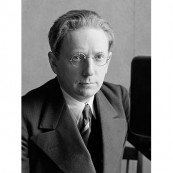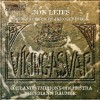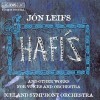Composers
Jón Leifs (1 May 1899 – 30 July 1968), was an Icelandic composer, pianist, and conductor.
Jón Leifs was born Jón Þorleifsson, at the farm Sólheimar, then in the Austur-Húnavatnssýsla, northwestern Iceland.[1] He left for Germany in 1916 to study at the Leipzig Conservatory. He graduated in 1921 having studied piano with Robert Teichmüller, but decided not to embark on a career as a pianist, devoting his time instead to conducting and composing. During this period he also studied composition with Ferruccio Busoni, who urged him to "follow his own path in composition".[2]
In the 1920s Jón Leifs conducted a number of symphony orchestras in Germany, Czechoslovakia, Norway and Denmark, thus becoming the only internationally successful Icelandic conductor to date,[1] although he failed to obtain a fixed position. During a tour of Norway, the Faroe Islands and Iceland with the Hamburger Philharmoniker, he gave the very first symphonic concerts in Iceland in the summer of 1926 (a total of 13 concerts with different programmes).[1] During this period, he was also very active as a writer on music and musical interpretation, both in German and Icelandic. Between 1925 and 1928, he travelled to Iceland on three occasions to record folk songs among the population in his home county Húnavatnssýsla in North Iceland. His observations on this were published in both Icelandic and German periodicals.
Beginning with piano arrangements of Icelandic folk songs, Jón Leifs started an active career as a composer in the 1920s.[1] From the 1930s he concentrated his efforts on the composition of large orchestral works, some of which were not performed until after his death. Most of his output is inspired by Icelandic natural phenomena. In the piece Hekla he depicts the eruption of the volcano Hekla which he witnessed. Dettifoss (Op. 57) was inspired by Dettifoss, Europe’s most powerful waterfall. In the Saga Symphony he musically portrays five characters from the classic Icelandic sagas.
In 1935 Jón Leifs was appointed Musical Director of the Icelandic National Broadcasting Service. However, having found it difficult to implement his vision for the radio service, he resigned from the post in 1937 and returned to Germany.
Jón Leifs married the pianist Annie Riethof soon after graduating from the Leipzig Conservatory.[1] They had two daughters, Snót and Líf, and made their home first in Wernigerode. Since Riethof was Jewish, the family lived under constant threat of Nazi persecution. In 1944, the couple managed to obtain permission to leave Germany and moved to Sweden with their daughters. However, by this time their marriage was showing signs of strain and they divorced in 1946. Jón Leifs later married, and divorced, a Swedish woman, Thea Andersson. His third wife, who survived him, was Þorbjörg Jóhannsdóttir Leifs (1919–2008). She and Jón had one son, Leifur (b. 1957).
In 1945 Jón Leifs moved back to Iceland (leaving his family in Sweden), and became a fierce proponent of music education and of artists’ rights. This included working for the ratification by Iceland of the Berne Convention, which happened in 1947, and setting up the Performing Rights Society of Iceland (STEF) in 1948.[1]
In 1947 tragedy struck. Jón Leifs’ younger daughter Líf drowned in a swimming accident off the coast of Sweden in 1947, aged only eighteen. Overcome with grief, he composed four works dedicated to her memory,[3] including Requiem Op. 33b for mixed choir, perhaps his most celebrated piece. The other works are Torrek Op. 33a, for solo voice and piano, Erfiljóð (In memoriam) Op. 35 for male choir, and the string quartet Vita et mors Op. 36.
Jón Leifs composed his last work, Consolation, Intermezzo for string orchestra, as he had only weeks to live. He died of lung cancer in Reykjavík in 1968.
Jón Leifs and his first wife are the subjects of the film Tears of Stone (Tár úr steini) (1995) by Icelandic director Hilmar Oddsson. A square in Bergholz-Rehbrücke (Nuthetal, Germany), where he lived with his family from the 1930s until 1944, is named after him.
Recently Added
Biography
Jón Leifs (1 May 1899 – 30 July 1968), was an Icelandic composer, pianist, and conductor.
Jón Leifs was born Jón Þorleifsson, at the farm Sólheimar, then in the Austur-Húnavatnssýsla, northwestern Iceland.[1] He left for Germany in 1916 to study at the Leipzig Conservatory. He graduated in 1921 having studied piano with Robert Teichmüller, but decided not to embark on a career as a pianist, devoting his time instead to conducting and composing. During this period he also studied composition with Ferruccio Busoni, who urged him to "follow his own path in composition".[2]
In the 1920s Jón Leifs conducted a number of symphony orchestras in Germany, Czechoslovakia, Norway and Denmark, thus becoming the only internationally successful Icelandic conductor to date,[1] although he failed to obtain a fixed position. During a tour of Norway, the Faroe Islands and Iceland with the Hamburger Philharmoniker, he gave the very first symphonic concerts in Iceland in the summer of 1926 (a total of 13 concerts with different programmes).[1] During this period, he was also very active as a writer on music and musical interpretation, both in German and Icelandic. Between 1925 and 1928, he travelled to Iceland on three occasions to record folk songs among the population in his home county Húnavatnssýsla in North Iceland. His observations on this were published in both Icelandic and German periodicals.
Beginning with piano arrangements of Icelandic folk songs, Jón Leifs started an active career as a composer in the 1920s.[1] From the 1930s he concentrated his efforts on the composition of large orchestral works, some of which were not performed until after his death. Most of his output is inspired by Icelandic natural phenomena. In the piece Hekla he depicts the eruption of the volcano Hekla which he witnessed. Dettifoss (Op. 57) was inspired by Dettifoss, Europe’s most powerful waterfall. In the Saga Symphony he musically portrays five characters from the classic Icelandic sagas.
In 1935 Jón Leifs was appointed Musical Director of the Icelandic National Broadcasting Service. However, having found it difficult to implement his vision for the radio service, he resigned from the post in 1937 and returned to Germany.
Jón Leifs married the pianist Annie Riethof soon after graduating from the Leipzig Conservatory.[1] They had two daughters, Snót and Líf, and made their home first in Wernigerode. Since Riethof was Jewish, the family lived under constant threat of Nazi persecution. In 1944, the couple managed to obtain permission to leave Germany and moved to Sweden with their daughters. However, by this time their marriage was showing signs of strain and they divorced in 1946. Jón Leifs later married, and divorced, a Swedish woman, Thea Andersson. His third wife, who survived him, was Þorbjörg Jóhannsdóttir Leifs (1919–2008). She and Jón had one son, Leifur (b. 1957).
In 1945 Jón Leifs moved back to Iceland (leaving his family in Sweden), and became a fierce proponent of music education and of artists’ rights. This included working for the ratification by Iceland of the Berne Convention, which happened in 1947, and setting up the Performing Rights Society of Iceland (STEF) in 1948.[1]
In 1947 tragedy struck. Jón Leifs’ younger daughter Líf drowned in a swimming accident off the coast of Sweden in 1947, aged only eighteen. Overcome with grief, he composed four works dedicated to her memory,[3] including Requiem Op. 33b for mixed choir, perhaps his most celebrated piece. The other works are Torrek Op. 33a, for solo voice and piano, Erfiljóð (In memoriam) Op. 35 for male choir, and the string quartet Vita et mors Op. 36.
Jón Leifs composed his last work, Consolation, Intermezzo for string orchestra, as he had only weeks to live. He died of lung cancer in Reykjavík in 1968.
Jón Leifs and his first wife are the subjects of the film Tears of Stone (Tár úr steini) (1995) by Icelandic director Hilmar Oddsson. A square in Bergholz-Rehbrücke (Nuthetal, Germany), where he lived with his family from the 1930s until 1944, is named after him.




